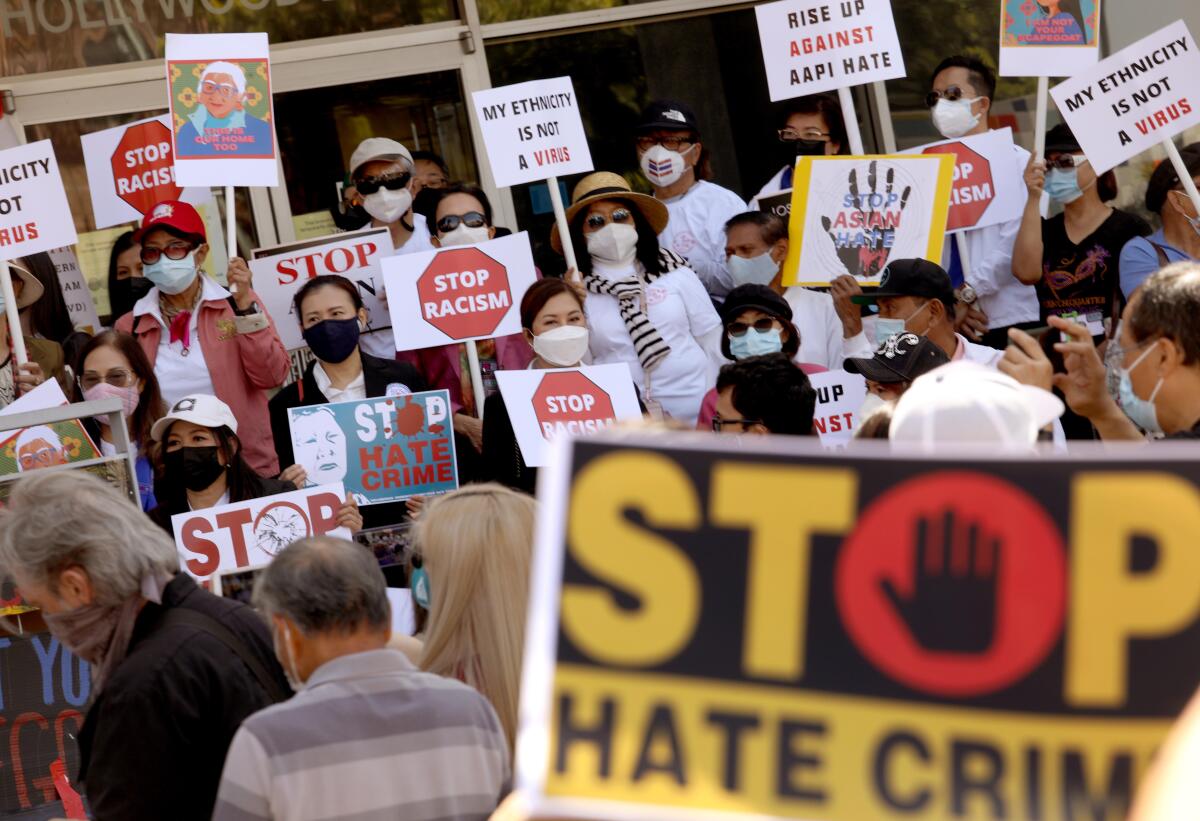As anti-Asian hate crimes surge, a new tool lets you report them anonymously

- Share via
Responding to increases in hate crimes and harassment of Asians and Asian Americans, a national advocacy group has launched an online tool to allow people to report incidents of violence or harassment in 29 languages.
The goal is to collect data to better gauge incidences of anti-Asian violence nationwide to help inform policymakers and community leaders and to assist in framing legislation.
Joon Bang, former president and CEO of the National Asian Pacific Center on Aging (NAPCA), said the tool was also made to uplift the voices of older members of AAPI communities.
It isn’t always easy for older people from Asian American Pacific Islander (AAPI) communities to report hate incidents, he said. “When you listen to our older adults, they come from a place of humility, so they’ll often say: ‘I don’t want you to spend the time or be concerned about what’s happening to me,’” Bang said.
It’s common, he added, for older, immigrant members of AAPI communities to feel guarded about sharing information. “Many of our older adults have this fear that if they do speak out or share information about what they’ve experienced, it could be used against them down the line,” Bang said.
In an effort to protect their safety and privacy, a feature of the online reporting form is a commitment to keeping the submitted information private.
The tool comes at a time when the nonprofit Orange County Human Relations Commission released its 2020 Hate Crimes Report that detailed an alarming rise in hate incidents in Orange County.
According to the report released Sept. 17, there was a 69% increase in the total number of hate incidents reported in 2020 versus 2019. Of the 263 reported cases, there was a 114% increase in antisemitic hate incidents, an 1,800% percent increase in anti-Asian incidents, and a 23% increase in anti-Black incidents. The report urges people to report crimes and harassment to local law enforcement agencies.
You can also report incidents using the NAPCA tool.
How does it work?
On the homepage of the NAPCA website, you can choose a language, then click the “report hate” button.
The next step is to fill out a form that asks for the name of the victim, which is optional; when and where the incident occurred; what type of incident it was; whether it was reported to the police; and information about the person submitting the report.
Identifying yourself is optional, and NAPCA said any personal information will remain private.
Why is the tool important?
Three in five AAPI adults experienced discrimination during the height of the pandemic, according to a nationwide survey conducted by NAPCA and its community partners in March.
Bang said the number of attacks against Asians is widely believed to be underreported. And the report found that language barriers and a cultural reluctance to report crimes has made data collection inconsistent.
The goal of the anonymous reporting tool is to improve the data collection.
It also provides policymakers and community leaders with disaggregated data, which Bang said is missing from existing reports.
“Because what affects the Chinese community might be different from the Vietnamese community, or the Cambodian community,” he said.
It’s also about giving communities a voice, Bang said.
“Language is more than just a tool. Language is ultimately about power,” he said.
Beyond the reporting form
If you need help beyond the reporting form, NAPCA created a live helpline — available Monday through Friday from 8:30 a.m. to 5 p.m. in eight languages: English, Japanese, Cantonese, Tagalog, Mandarin, Vietnamese, Korean and Spanish. Visit their website that lists specific phone numbers for each language.
If you’re a bystander to an incident here are ways to effectively intervene and be an ally.
Distract. Interrupt the incident and indirectly derail the attacker. One method is by making conversation. Approach the targeted person and start talking about something unrelated. Another method is creating a small distraction like dropping something on the ground.
Delegate. If you don’t feel safe intervening, you can help by documenting the incident in an unobtrusive way.
Delay. You might not feel safe intervening until after the attacker has moved on. Once that happens, you can still help by checking in with the victim. Express solidarity and let them know that what happened wasn’t OK, and that you want to check in.
Direct. Only do this if you feel safe and comfortable speaking up. This is the riskiest response, because you can’t know how the perpetrator will react. If you do feel safe, say something like, “Leave them alone,” or “That’s inappropriate/racist/disrespectful/not OK.” Keep it short and don’t engage in a discussion or argument.
Another method of assisting your AAPI neighbors, friends and community members is by practicing solidarity which could come in the form of uncomfortable conversations or identifying when it’s helpful to stand up and when it’s better to step back.
Times assistant editors Jessica Roy and Ada Tseng contributed to this report.
More to Read
Sign up for Essential California
The most important California stories and recommendations in your inbox every morning.
You may occasionally receive promotional content from the Los Angeles Times.











